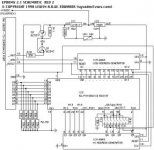Chuck(G)
25k Member
No maximum limit--a 150 nsec. minimum limit. However, know that when an input needs to be at a high level, it's good practice to tie the input to Vcc through a resistor (2-10K) and not directly.
However, know that when an input needs to be at a high level, it's good practice to tie the input to Vcc through a resistor (2-10K) and not directly.
The 28C64 is a CMOS chip. Because of the high input impedance of CMOS inputs, one should never leave a CMOS input "floating"--charges can build up and cause unpredictable results.
Your switches should data lines to ground and you should use pull-up resistors (4K7 is okay) to Vcc. That is the conventional way of doing things.
VCC
+
|
|
.-.
| |4K7
| |
'-'
|
+--------------+CMOS input
\ o
\
\.
o
|
|
===
GNDNo, ground or Vcc, not both. As Chuck says, the conventional way is to pull up to Vcc and connect to ground through the switch and that made sense with TTL logic because pulling up drew much less current than pulling down. With CMOS it doesn't really matter, although having the switch common connected to ground instead of Vcc is not only the conventional (although unintuitive to some) way of doing it, it can also have a slight noise advantage in some situations.Yes, i have connected 4k7 resistance to ground should i connect V cc also with some low value resistance or it is just ok??

8085 memory space between 0000h-1FFFh
and why, the RAM add. should starts at 8000h to 9FFFh ??
is there any rule for that?
RThere is no rule about where to put the RAM, but 8000h-9FFFh is the simplest solution because it limits the address decoding to only one address line (A15). In such a case, a simple NOT gate is enough for the implemention of address decode for memory.
I should also add that a 74LS138 multiplexer on A13-A15 will provide chip selects every for every 8K block of addresses and speaking from a real-estate point of view, is probably just as efficient.
The advantage offered by partial decoding (using A15) to select between RAM and ROM is that you can expand either ROM or RAM without re-working your address decoding logic.
Why A13-A15 pins are not used of 8085 to locate memory in ROM??
as it s said 8085 has 16bit memory add.??
Because you have an 8KB device (2864). Since A15 is used to select between ROM and RAM (it's not unused), you can connect up to a 32KB (e.g. M28256) device up for your ROM, if you desire. In that case, A13 and A14 would be used.
How you are saying it is 8KB ROM, a 2864 is 64Kb....??
we use RAM to increase processing speed, but how actually it takes Data from ROM and we have to write add........
You're playing with me, aren't you?
